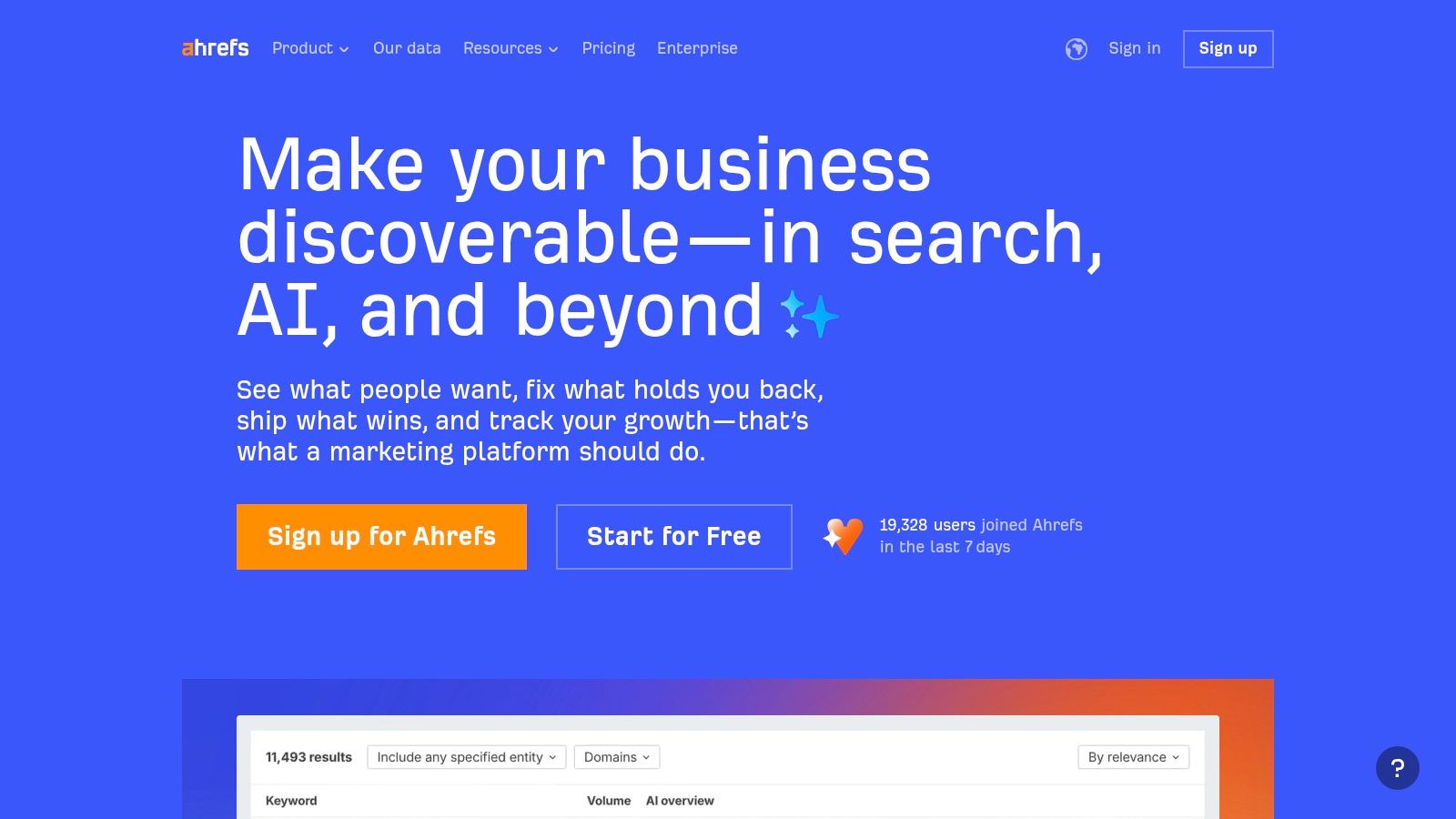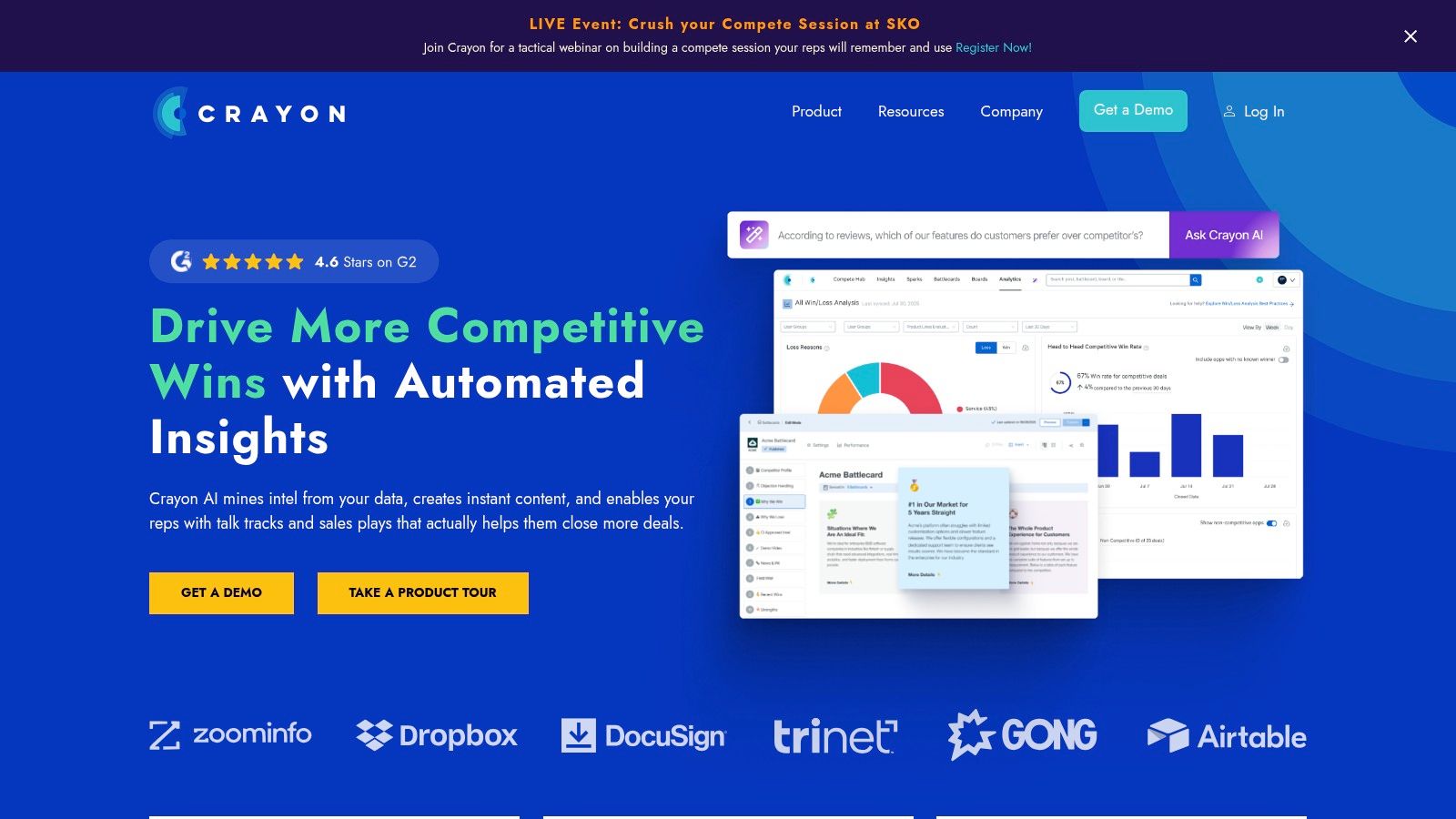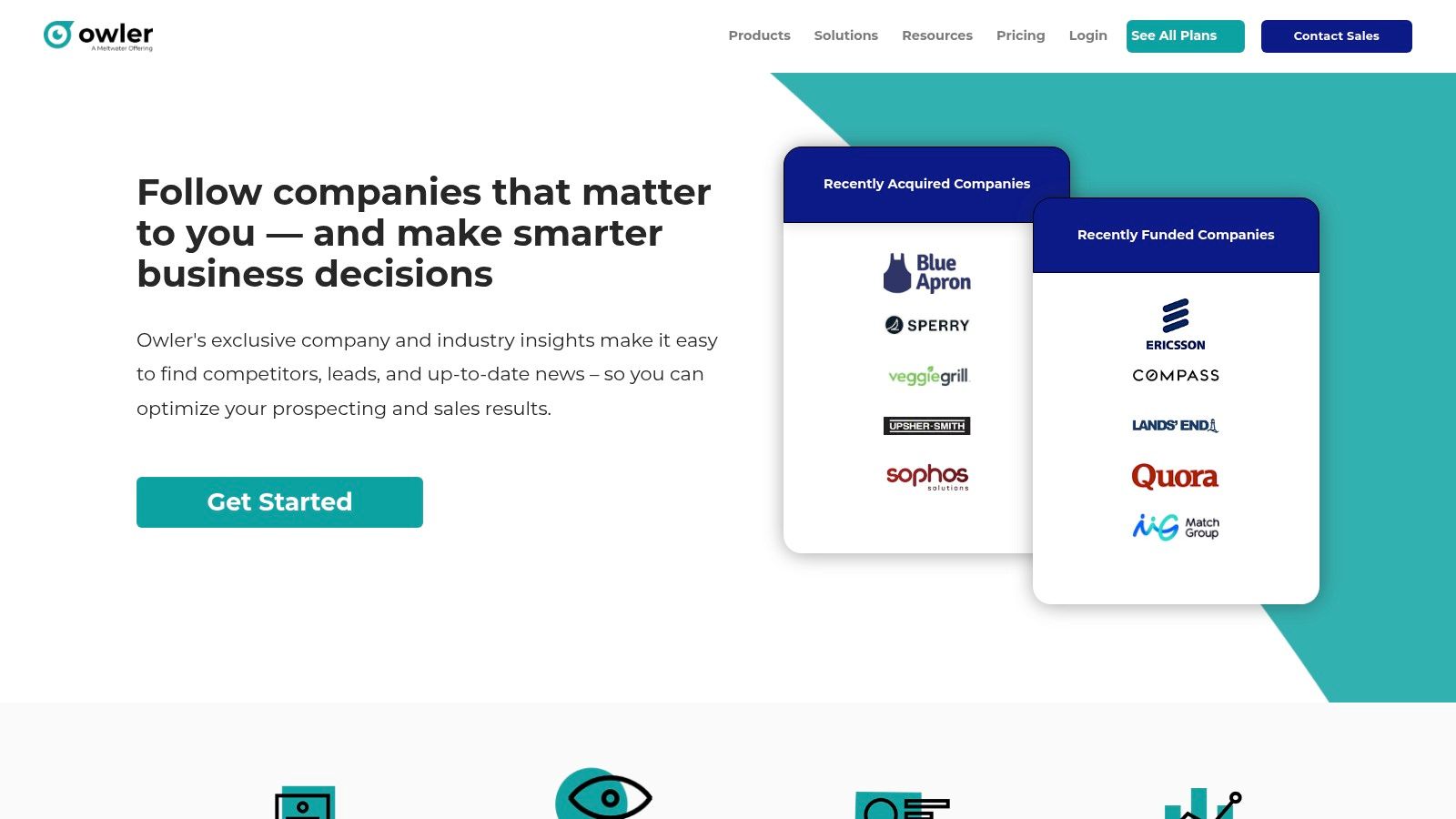In today's crowded digital marketplace, understanding your competition isn't just an advantage-it's essential for survival and growth. For small to medium-sized enterprises (SMEs) and e-commerce businesses across the UK, knowing what your rivals are doing well, where they're falling short, and what opportunities they're missing can directly inform your own strategy.
A robust competitor analysis framework, powered by the right tools, allows you to benchmark performance, uncover keyword and content gaps, and make data-driven decisions that give you a genuine competitive edge. This guide cuts through the noise to provide an in-depth review of the best competitor analysis tools available, helping you select the perfect platform to refine your marketing, SEO, and product strategies. We will explore each tool's unique strengths, practical applications for SMEs, pricing considerations, and honest limitations to ensure you invest wisely.
The success of any competitive analysis hinges on accurate and comprehensive data; learn more about best practices for web scraping and data collection using proxies to ensure your insights are built on a solid foundation.
Inside this comprehensive resource, you will find detailed breakdowns of platforms like Semrush, Ahrefs, Similarweb, and SpyFu, each accompanied by screenshots and direct links to help you navigate your options. Our goal is to move beyond generic feature lists and offer a practical, honest assessment of how these tools perform in real-world scenarios, empowering your business to stay ahead of the curve.
1. Semrush: The All-in-One SEO & Marketing Competitor Suite
Semrush stands out as one of the best competitor analysis tools because it offers a deeply integrated, all-in-one suite covering SEO, PPC, content, and market research. For a UK-based e-commerce business, it’s invaluable for benchmarking your traffic against rivals like Argos or John Lewis, pinpointing the exact organic and paid keywords they rank for.
The platform's strength lies in its unified workflow. You can seamlessly move from identifying a competitor’s top-performing content to analysing the backlinks that support it, all within a single interface. Its Market Explorer feature provides a high-level view of the competitive landscape, showing audience overlap and market share, which is crucial for understanding your position and identifying new challengers. This comprehensive approach saves significant time compared to using multiple disparate tools.
Key Features & Use Cases
- Keyword Gap: A practical application involves using the Keyword Gap tool to find valuable keywords that two or more of your main competitors rank for, but you don't. This generates a prioritised list of optimisation opportunities to capture qualified traffic.
- Domain vs. Domain: Directly compare your domain against up to four competitors to visualise performance gaps in organic keywords, paid search, and backlinks.
- Traffic Analytics: Estimate any website's traffic to gauge a competitor's market share and audience engagement, helping you set realistic performance benchmarks.
Pricing & Suitability
Pricing starts from around £100 per month for the Pro plan, scaling up with more advanced features and user licences. While the sheer volume of data can present a learning curve for newcomers, its depth is second to none for SMEs and e-commerce businesses serious about digital growth. The platform’s extensive toolkit, which is covered in a detailed SEO software comparison on bare-digital.com, justifies the investment for those ready to scale.
Pros:
- Extremely deep, integrated toolkit covering most competitor workflows.
- Powerful market and traffic benchmarking modules.
- Robust integrations with tools like Looker Studio for customised reporting.
Cons:
- Pricing can become steep with add-ons and additional user licences.
- The sheer volume of features presents a significant learning curve.
Website: https://www.semrush.com
2. Ahrefs: The Powerhouse for Backlink & Content Analysis
Ahrefs has earned its reputation as one of the best competitor analysis tools primarily through its immense and highly accurate backlink index. For a Cambridge-based consultancy aiming to outrank local competitors, it provides an unparalleled ability to reverse-engineer the precise link-building and content strategies that drive their rivals' search visibility.

The platform’s core strength is its data depth, particularly within its Site Explorer tool. You can quickly uncover a competitor's top-performing pages by traffic and value, then see exactly which websites link to them. This creates a clear roadmap for your own outreach and content creation efforts, moving beyond guesswork to data-driven decision-making. Its user interface is widely praised for making complex SEO data accessible and actionable.
Key Features & Use Cases
- Site Explorer: Enter any competitor's domain to see their organic keywords, referring domains, and most valuable pages. This is perfect for identifying link-building opportunities, as explained in this guide on how to build backlinks at bare-digital.com.
- Content Explorer: Discover the most shared and linked-to content in your niche. This helps you analyse what topics resonate with your target audience and ideate content that is primed for success.
- Site Audit: Run a technical audit on a competitor’s site to find weaknesses in their on-page SEO, such as slow page speed or broken links, creating an opportunity for you to gain a technical advantage.
Pricing & Suitability
Pricing begins at around £79 per month for the Lite plan, which is suitable for small businesses and freelancers. However, heavy usage and team access often necessitate higher-tier plans due to the platform's credit-based system. While it focuses more on SEO-centric analysis compared to all-in-one suites, its specialisation is its greatest asset for SMEs and e-commerce businesses focused on organic growth.
Pros:
- Best-in-class backlink and keyword databases for deep analysis.
- Intuitive interface that simplifies complex SEO data.
- Excellent for discovering competitor content and link opportunities.
Cons:
- Credit-based usage limits can be restrictive on lower-tier plans.
- Lacks the broad market analysis features found in some competitors.
Website: https://ahrefs.com
3. Similarweb: The Digital Market Intelligence Leader
Similarweb earns its place as one of the best competitor analysis tools by focusing on high-level digital market intelligence. While others zoom in on keyword-level data, Similarweb provides a panoramic view of your market, making it essential for strategic planning. A UK-based startup, for example, can use it to size up an entire market category, understand the traffic share of incumbents, and identify audience overlap to find partnership opportunities.
The platform's core strength is its ability to benchmark performance at a market-wide scale. It excels at answering big-picture questions: "How large is this digital market?", "Who are the key players by traffic share?", and "What channels drive the most success in this industry?". Its Web Intelligence features provide deep insights into competitor traffic sources and engagement metrics, allowing you to gauge the effectiveness of their marketing strategies and set realistic benchmarks for your own campaigns.
Key Features & Use Cases
- Market Share & Category Benchmarking: A key application is analysing your industry category to understand your "share of voice". You can identify who is gaining or losing traffic share over time, revealing emerging threats or opportunities.
- Competitor Traffic and Sources: Dive into a rival's website to see their total traffic, bounce rate, and time on site. More importantly, you can analyse where their traffic comes from, whether it's organic search, paid ads, social media, or referrals.
- SERP and Ads Analysis: Examine a competitor's top-performing keywords and ad creatives to deconstruct their acquisition strategy, providing direct inspiration for your own SEO and PPC efforts.
Pricing & Suitability
Similarweb offers a limited free tier, but its true power is unlocked in the paid plans, which are customised and often geared towards enterprise clients. Pricing is typically provided upon request, but it is known to be a significant investment. For SMEs and e-commerce businesses, its high-level strategic data is invaluable for market research and investor pitches, although the cost may be prohibitive for those needing only operational SEO data.
Pros:
- Excellent for market-level and domain-level competitive benchmarks.
- Provides powerful insights for category sizing and share-of-voice analysis.
- User-friendly interface for visualising complex market data.
Cons:
- The free version offers very limited data and functionality.
- Full-featured plans are enterprise-level and can be expensive for smaller businesses.
Website: https://www.similarweb.com
4. SpyFu: The PPC & SEO Historical Data Specialist
SpyFu earns its place as one of the best competitor analysis tools by focusing intensely on historical search data, particularly for PPC. It allows UK businesses to essentially travel back in time to see a competitor’s paid ad copy and keyword strategy from months or even years ago. This makes it an unparalleled resource for reverse-engineering successful (and unsuccessful) advertising campaigns.
The platform excels at revealing the financial side of search. You can uncover a competitor’s estimated monthly AdWords budget, see every keyword they’ve ever bought, and analyse the ad variations they’ve tested. This is invaluable for an e-commerce store planning a product launch, as it helps you estimate the ad spend required to compete and identify profitable keywords that rivals have already proven to work, de-risking your own campaign.

Key Features & Use Cases
- PPC Ad History: Uncover a competitor's most profitable keywords and ad copy from over 15 years of data. This helps you skip the costly trial-and-error phase by adopting strategies that have already performed well for others in your market.
- Kombat Domain Comparison: Use this feature to find keywords your competitors are ranking for that you aren't, creating a clear roadmap for your SEO and content strategy to close the gap.
- Top Lists: Identify the top websites by ad spend or organic traffic in any given niche, helping you discover new or indirect competitors you may have overlooked.
Pricing & Suitability
Pricing is highly competitive, with basic plans starting from around £30 per month. SpyFu is known for offering generous data allowances, with higher-tier plans providing unlimited search results and data exports. This makes it a great-value option for SMEs and marketing consultants focused heavily on search engine marketing. While its interface can feel less modern than some rivals and is best suited to search-centric analysis, its depth in PPC intelligence is hard to beat for the price.
Pros:
- Excellent historical PPC and keyword data for in-depth analysis.
- Affordable entry price point with generous data limits on all plans.
- Powerful for reverse-engineering competitor ad strategies.
Cons:
- The user interface can be less intuitive for beginners.
- Primarily focused on search, with less functionality for social or content analysis.
Website: https://www.spyfu.com
5. BuzzSumo: The Ultimate Content & PR Competitor Insight Platform
BuzzSumo excels as one of the best competitor analysis tools by focusing specifically on content, PR, and digital influence. It enables you to quickly identify the content that performs best for your competitors, pinpointing the topics, formats, and headlines that resonate most with their audience. For a UK-based B2B service provider, this means you can instantly see which blog posts or case studies from rivals are earning the most social shares and backlinks, providing a clear blueprint for your own content efforts.
The platform’s core strength is its ability to reveal what's currently engaging audiences and who the key influencers are in any niche. Its Content Analyser shows you exactly which articles are trending across social media, while its journalist database helps you find relevant media contacts who have covered your competitors. This focus on content and outreach makes it an indispensable tool for marketing and communications teams looking to gain a competitive edge through earned media and superior content marketing.
Key Features & Use Cases
- Content Analyser: Enter a competitor’s domain to see their most-shared content from the past year. This reveals their successful content pillars and helps you identify gaps in your own strategy, a key step when you need to develop a new content strategy for your business.
- Backlink Analyser: Discover which websites are linking to your competitor’s top-performing content. This generates a prioritised list of high-value outreach targets for your own link-building campaigns.
- Alerts & Monitoring: Set up real-time alerts for when a competitor is mentioned online, publishes new content, or when specific keywords are trending. This allows for reactive PR and marketing opportunities.
Pricing & Suitability
Pricing begins at around £95 per month for the Pro plan, with more advanced features like the journalist database and comprehensive content analysis reserved for higher tiers. While it doesn't offer the broad SEO and PPC features of an all-in-one suite, its specialised focus makes it perfect for SMEs and e-commerce businesses whose primary growth channel is content marketing and digital PR.
Pros:
- Excellent at quickly discovering engaging and viral competitor content.
- Invaluable for PR monitoring and identifying relevant journalists for outreach.
- Simple, intuitive interface that is easy to get started with.
Cons:
- Deeper content and influencer features are gated behind more expensive plans.
- Enterprise-level functionality often requires an annual commitment.
Website: https://buzzsumo.com
6. Brandwatch: Enterprise Social Listening & Consumer Intelligence
Brandwatch shifts the focus from SEO and website traffic to the court of public opinion: social media. It stands as one of the best competitor analysis tools for understanding brand perception and consumer sentiment at a massive scale. For a UK retail brand, this means you can monitor real-time conversations about your rivals, analyse the sentiment around their latest product launch, and identify key influencers driving those discussions.
Its primary strength is its enterprise-grade social listening capability. The platform can sift through millions of online conversations across social media, forums, and news sites to provide a detailed picture of your competitor's social footprint. This allows you to benchmark share of voice, track sentiment trends over time, and receive alerts on emerging PR crises or viral content related to your competition, offering a qualitative layer that technical SEO tools often miss.

Key Features & Use Cases
- Competitor Monitoring: Set up detailed queries to track every mention of your competitors, segmenting conversations by positive, negative, or neutral sentiment to gauge public opinion accurately.
- Consumer Insights: Use its advanced dashboards to identify key topics and themes driving conversations in your industry. This helps you spot gaps in a competitor's messaging or service that you can exploit.
- Influencer Discovery: Identify influential voices who are already talking about your competitors, providing a ready-made list of potential partners for your own marketing campaigns.
Pricing & Suitability
Brandwatch operates on a custom pricing model tailored to enterprise needs, which generally places it outside the budget of most startups and SMEs. The platform requires a dedicated onboarding process to configure its powerful queries and dashboards effectively. However, for larger organisations where social brand health is a critical performance indicator, its depth of consumer intelligence and unified social media management suite provides an unparalleled competitive advantage.
Pros:
- Extremely deep and scalable social listening capabilities.
- Unified suite combines listening, management, and influencer tools.
- Powerful data visualisation and real-time alerting features.
Cons:
- Pricing is aimed at enterprise-level budgets and is not publicly available.
- Requires a significant setup and onboarding investment to use effectively.
Website: https://www.brandwatch.com
7. Crayon: The Competitive Intelligence Engine for Sales Enablement
Crayon shifts the focus of competitor analysis from marketing metrics to sales enablement and go-to-market (GTM) strategy. It excels at automatically tracking a competitor's complete digital footprint, including website changes, product launches, and new marketing collateral. For a B2B SaaS firm in the UK, this means getting real-time alerts when a rival updates its pricing page or releases a new case study, providing actionable intelligence to front-line teams.
The platform is designed to operationalise this intelligence. Instead of just gathering data, Crayon helps you centralise it into dynamic "battlecards" and win-loss analyses. This ensures your sales and marketing teams are armed with the most current, relevant information to counter competitor claims and position your solution effectively. This specialisation makes it one of the best competitor analysis tools for organisations looking to directly link competitive insights to revenue generation.

Key Features & Use Cases
- Automated Tracking: Set up automated monitoring of competitors' websites, content libraries, and online reviews to capture every significant change without manual effort. This is ideal for tracking subtle shifts in messaging or product features.
- Centralised Battlecards: Create and distribute live, easily-digestible battlecards that equip your sales team with key talking points, objection handling tips, and up-to-date intel on rival products.
- Win-Loss Intelligence: Aggregate and analyse feedback from sales calls to understand why you win or lose deals against specific competitors, feeding insights back into product and marketing strategies.
Pricing & Suitability
Crayon does not publish its pricing publicly, following a customised enterprise-style quoting model. It is best suited for mid-market and enterprise-level businesses where the alignment between competitive intelligence and sales performance is a critical priority. For smaller SMEs, the investment may be substantial, but for companies focused on scaling their GTM teams, the platform provides a clear framework for turning market intelligence into a competitive advantage.
Pros:
- Purpose-built for competitive intelligence and sales readiness.
- Automates the collection of a wide range of competitor activities.
- Helps operationalise competitor intel directly for revenue teams.
Cons:
- Pricing is not transparent and requires a direct sales consultation.
- Best value is typically realised at a mid-market or enterprise scale.
Website: https://www.crayon.co
8. Kompyte (by PathFactory): Competitive Intelligence for Sales Enablement
Kompyte positions itself as a competitive intelligence tool designed to move insights from the marketing department directly into the hands of sales teams. Its core strength is automating the tracking of competitors and translating those findings into actionable sales battlecards and reports. For a UK-based B2B SaaS company, Kompyte is crucial for equipping its salesforce with real-time data to counter competitor claims during calls and demos, effectively shortening the sales cycle.

The platform excels at operationalising competitive intelligence through seamless integrations. By connecting directly with tools like Salesforce, HubSpot, Slack, and Microsoft Teams, it ensures that intelligence doesn’t just sit in a dashboard but actively informs conversations where it matters most. This focus on sales enablement and process integration makes it one of the best competitor analysis tools for organisations looking to directly link market awareness to revenue generation.
Key Features & Use Cases
- Automated Competitor Tracking: Set up automated alerts to monitor competitor website changes, new content, pricing updates, and social media activity, feeding insights directly into your workflow.
- Sales Battlecards: Create and distribute dynamic, easily accessible battlecards that arm your sales team with key differentiators, objection handling points, and competitor weaknesses.
- CRM & Slack/Teams Integration: A practical use case involves an alert about a competitor's new feature being pushed directly to a specific Slack channel and updating the relevant battlecard in Salesforce, ensuring the entire team is immediately aligned.
Pricing & Suitability
Kompyte does not list pricing publicly, as it is typically based on the number of competitors tracked and user licences required, with annual contracts being the standard. While this model requires a direct sales conversation, it allows for a tailored solution. The platform includes dedicated onboarding and customer success support, making it well-suited for mid-market and enterprise businesses that need to systematically deploy competitive intelligence across their sales and marketing functions.
Pros:
- Excellent integrations with CRM, sales enablement, and communication platforms.
- Strong focus on creating actionable sales battlecards and reports.
- Includes dedicated onboarding and customer success support.
Cons:
- Pricing is not transparent and requires a sales consultation.
- Primarily focused on sales enablement rather than technical SEO or PPC analysis.
Website: https://www.kompyte.com
9. Owler: The Real-Time Company Intelligence Tracker
Owler carves out its niche as one of the best competitor analysis tools by focusing on real-time company intelligence and news tracking rather than deep technical SEO data. For a UK-based startup looking to monitor a wide array of competitors without a significant financial outlay, Owler offers an efficient way to stay informed about funding rounds, leadership changes, and major press announcements.
The platform excels at providing a continuous, automated stream of competitor updates directly to your inbox. Its strength lies in its simplicity and breadth of coverage. You simply "follow" companies, and Owler aggregates public data and news, creating a curated feed that helps you understand competitor movements, potential acquisition targets, or even partnership opportunities. This makes it an invaluable, low-effort tool for sales, marketing, and strategy teams who need to keep a finger on the pulse of their industry.

Key Features & Use Cases
- Competitor News Feed: Set up alerts for a list of competitors to automatically receive daily or weekly digests of their latest news, press releases, and blog posts, ensuring you never miss a significant development.
- Competitive Relationships Mapping: Quickly visualise a company’s primary competitors, suppliers, and partners. This is useful for identifying secondary competitors or understanding the broader ecosystem a rival operates within.
- Funding and Acquisition Alerts: A practical application is tracking the investment and M&A activity in your sector. This helps you spot emerging, well-funded challengers before they become major threats.
Pricing & Suitability
Owler offers a free plan with limited follows and features, making it highly accessible. The Pro plan starts from around £35 per month, unlocking unlimited follows and advanced features like the browser extension. While it lacks the deep SEO or PPC data of platforms like Semrush, its affordability makes it perfect for SMEs and startups needing lightweight, high-level competitive intelligence without the complexity or cost of enterprise-grade suites.
Pros:
- An extremely fast and efficient way to monitor many competitors at once.
- Excellent value for businesses focused on news-driven competitive intelligence.
- Simple, user-friendly interface that requires minimal training.
Cons:
- Prioritises data breadth over the analytical depth of full CI or SEO suites.
- Deeper integrations and API access are reserved for expensive enterprise tiers.
Website: https://www.owler.com
10. Crunchbase: The Go-To for Company & Funding Intelligence
Crunchbase offers a different angle on competitor analysis, focusing on corporate and financial intelligence rather than just digital marketing metrics. For a growing UK tech startup, it's the ideal tool to track a competitor's funding rounds, key executive hires, and acquisition news. This provides powerful signals about their strategic direction, financial health, and potential market expansion, going beyond keyword rankings to understand their business momentum.
The platform's strength lies in its comprehensive database of company profiles, which acts as a business-focused social network. You can follow companies to receive real-time alerts on significant events, helping you react quickly to market shifts. Unlike SEO suites, Crunchbase answers crucial business questions: "Who are my competitors' main investors?" and "Are they hiring for a new product launch?" This insight is invaluable for strategic planning, fundraising, and identifying partnership or acquisition opportunities.

Key Features & Use Cases
- Advanced Search & Alerts: A practical use is to set up alerts for your top three competitors. You'll be notified automatically about new funding rounds, press mentions, or leadership changes, providing timely intelligence without manual checks.
- Firmographics & Growth Signals: Analyse a competitor’s employee growth over time, identify their technology stack, and view their leadership team. This helps you map their operational scale and strategic investments.
- Investor & Funding Data: Before seeking investment, you can research which venture capital firms have funded similar companies in your space, creating a targeted list of potential investors who understand your market.
Pricing & Suitability
Crunchbase offers a limited free version, but meaningful analysis requires a paid plan. The Pro plan starts at around £40 per user per month and unlocks advanced search, data exports, and integrations. While its primary focus isn't on day-to-day SEO or PPC tactics, it is an essential tool for founders, strategists, and business development teams needing to understand the deeper competitive landscape. For B2B companies, it is one of the best competitor analysis tools for mapping an entire industry.
Pros:
- Excellent for tracking competitor financing, hiring, and growth signals.
- Provides deep insights into corporate structure and key personnel.
- Flexible and relatively affordable monthly Pro option for SMEs.
Cons:
- Free access is very limited, making a paid plan almost necessary.
- Contact data and deep enrichment features require costly add-ons.
- Not a direct tool for digital marketing or SEO analysis.
Website: https://www.crunchbase.com
11. BuiltWith: Technographic Intelligence for a Deeper Look
BuiltWith offers a unique angle among the best competitor analysis tools by focusing entirely on technographics. It tells you exactly what technologies a competitor’s website is built with, from their analytics and tracking tools to their e-commerce platform and CRM. For a UK business evaluating a rival’s operations, this insight is invaluable for understanding their technical investments and capabilities.
The platform's power lies in its ability to reveal a company’s digital infrastructure, which often signals its strategic priorities. Discovering a competitor has recently implemented Hubspot, for instance, suggests a renewed focus on inbound marketing and lead nurturing. This kind of intelligence is difficult to find elsewhere and allows you to anticipate their next moves, whether in marketing automation, A/B testing, or customer support. It moves beyond keywords and backlinks to analyse the very foundation of their online presence.
Key Features & Use Cases
- Technology Profiles: Generate a complete profile of any website’s technology stack. This is useful for sales and partnership teams looking to find companies that use a specific, complementary technology.
- Historical Trends: See which technologies a competitor has added or removed over time. A switch from Magento to Shopify Plus, for example, could indicate a strategic shift towards a more scalable e-commerce solution.
- Lead Generation & List Building: Create lists of websites based on the technologies they use, which is a powerful tool for B2B companies whose product integrates with specific platforms.
Pricing & Suitability
Pricing is flexible, starting from around £225 per month for the Basic plan, with options to cancel at any time. Higher tiers cater to larger teams needing more comprehensive data access and integrations. BuiltWith is less of an all-in-one SEO suite and more of a specialised intelligence tool. It is ideal for B2B sales teams, marketers, and developers who need to understand the technical landscape of their market or qualify leads based on their tech stack.
Pros:
- Provides clear, unparalleled insight into a competitor’s web technology stack.
- Historical data helps you track a competitor's strategic technology changes.
- Straightforward pricing model with cancel-anytime flexibility.
Cons:
- Highly specialised; it is not a full competitive intelligence platform.
- Pricing for larger teams and advanced features can be expensive.
Website: https://builtwith.com
12. data.ai (formerly App Annie): The Mobile App Intelligence Leader
For any business where a mobile app is a core part of the customer journey, data.ai is an essential competitive analysis tool. Formerly App Annie, it stands as the industry standard for app market intelligence, offering unparalleled insights into downloads, revenue, user engagement, and advertising within the mobile ecosystem. A UK-based fintech startup, for example, could use it to benchmark its app's performance against Monzo or Revolut, identifying market share and user demographic gaps.
The platform’s core strength is its singular focus on the app economy. While other tools touch upon mobile traffic, data.ai provides deep, granular data on store rankings, feature updates, and user reviews over time. Its Intelligence suite allows businesses to size up markets, understand category leaders, and analyse the strategies behind the most successful apps, from monetisation tactics to user acquisition channels. This makes it one of the best competitor analysis tools specifically for mobile-first or mobile-centric organisations.
Key Features & Use Cases
- App Store Optimisation (ASO): Analyse competitors’ keywords, ratings, and reviews to identify opportunities to improve your app's visibility and conversion rate in the App Store and Google Play.
- Market & Category Benchmarking: Evaluate your app's download and revenue performance against the wider market or specific categories to set realistic growth targets and understand your competitive position.
- Usage Intelligence: Gain insight into active users, session duration, and retention rates for competitor apps to diagnose engagement strengths and weaknesses.
Pricing & Suitability
data.ai operates on a freemium model. The free 'Connect' tier is useful for tracking your own app's performance, but comprehensive competitor data requires a premium 'Intelligence' subscription. Pricing is not public and is typically enterprise-level, making it a significant investment. However, for businesses heavily reliant on their mobile app for revenue, the depth of its competitive data is often indispensable. It is also one of the key players covered in guides to Google Analytics alternatives for mobile apps.
Pros:
- Deep, specialised intelligence for the mobile app economy.
- The standard reference for mobile market sizing and app rankings.
- Powerful features for ASO and user engagement analysis.
Cons:
- Premium pricing is aimed at the enterprise level and not publicly available.
- The free version offers very limited competitive insights.
Website: https://www.data.ai
Top 12 Competitor Analysis Tools — Feature Comparison
| Tool | Core focus / key features | Strengths | Weaknesses | Best for (target audience) | Typical pricing note |
|---|---|---|---|---|---|
| Semrush | Integrated SEO / PPC / content + market & traffic analytics (Keyword/Backlink Gap, Position Tracking) | Deep, all-in-one toolkit; strong market benchmarking; many integrations | Can get expensive with add-ons; learning curve | Agencies, in-house SEO/PPC teams, market analysts | Tiered subscriptions; add-ons raise cost |
| Ahrefs | Backlink & keyword database, Site Explorer, Content Explorer, Site Audit | Excellent backlink/keyword depth; great for content & link opportunity discovery | Usage/credit limits for teams; some reporting add-ons | SEOs focused on link research & content, agencies | Subscription tiers; higher plans for teams |
| Similarweb | Market intelligence & share-of-traffic (web & app insights, category benchmarks) | Strong market/domain benchmarking and category sizing | Free tier limited; enterprise plans costly | Market analysts, product teams, strategy leads | Paid tiers; enterprise-priced |
| SpyFu | PPC & SEO competitor history (ad spend, keyword history, Kombat comparisons) | Affordable entry for PPC visibility; generous historical data | UI can be dense; focused mainly on search use-cases | PPC specialists, SMB marketers, competitive PPC research | Affordable entry plans; higher tiers unlock more data |
| BuzzSumo | Content performance, backlink analysis, alerts, influencer & media database | Fast discovery of top-performing content; good for PR/outreach | Advanced features behind higher tiers; enterprise often annual | Content marketers, PR teams, outreach managers | Tiered pricing; enterprise features often annual |
| Brandwatch | Enterprise social listening, sentiment, influencer tools, social management | Deep social listening at scale; unified listening + management suite | Custom pricing; significant onboarding | Enterprise comms, social teams, consumer insights | Custom / enterprise pricing |
| Crayon | Automated competitor tracking, battlecards, win-loss intelligence | Purpose-built for CI and sales readiness; operationalises intel | Pricing by quote; best value at mid/enterprise scale | Product marketing, sales enablement, GTM teams | Enterprise-style quoting |
| Kompyte (PathFactory) | CI automation, battlecards, CRM & collaboration integrations (Salesforce, HubSpot, Slack) | Integrations included; dedicated onboarding & CS support | Annual contracts typical; pricing varies by tracked competitors | Sales enablement, competitive ops, CRM-connected teams | Quoted pricing; annual contracts usual |
| Owler | Company news, alerts, competitive relationships, fast competitor monitoring | Quick, low-cost way to monitor many competitors | Deeper integrations/API on higher tiers; coverage over depth | SMBs needing lightweight company monitoring | Affordable plans; Pro/Enterprise for more features |
| Crunchbase | Company intelligence: funding, investors, firmographics, alerts | Excellent for funding & growth signal tracking; flexible monthly Pro | Best data behind paid tiers; contact volumes require add-ons | BD, investors, market researchers, sales prospecting | Pro/Business paid tiers; contact add-ons |
| BuiltWith | Technographic intelligence & historical tech stack data, exports | Clear tech-stack visibility; simple pricing and cancel-anytime | Focused only on web technology (not full CI) | Product, BD, targeting, account-based sales teams | Straightforward paid plans |
| data.ai (App Annie) | Mobile app market intelligence (downloads, revenue, rankings, ad spend) | Deep app-economy insights; standard for mobile market sizing | Enterprise-priced; free tier limited for competitors | Mobile product teams, publishers, app marketers | Enterprise pricing; limited free Connect option |
Choosing the Right Tools for Your Competitive Strategy
Navigating the landscape of competitor analysis software can feel overwhelming. We've explored a wide array of platforms, from all-in-one SEO and marketing suites like Semrush and Ahrefs to specialised competitive intelligence (CI) tools like Crayon and social listening powerhouses such as Brandwatch. The central takeaway is clear: there is no single "best" tool, only the tool that is best for your specific business objectives.
The journey to effective competitor analysis doesn't end with a subscription. It begins with a clear understanding of what you need to achieve. Are you an e-commerce business in Cambridgeshire focused on outranking local rivals on Google? Ahrefs' backlink analysis and Semrush's keyword gap features will be your bread and butter. Are you a B2B SaaS company trying to understand market positioning and sales messaging? A dedicated CI platform like Kompyte, combined with financial insights from Owler, will deliver more relevant value.
From Data Collection to Actionable Strategy
The true power of the best competitor analysis tools lies not in the data they provide, but in the strategic actions they empower. Simply knowing your competitor’s top keywords is passive information; using that insight to refine your own content strategy, create targeted landing pages, and adjust your ad spend is what drives growth. The goal is to create a continuous feedback loop where insights inform action, and the results of those actions are measured and refined.
To move from passive data gathering to an active competitive strategy, consider these implementation factors:
- Integration: How well will a new tool fit into your existing workflow? Can it integrate with your CRM, project management software, or Slack to ensure insights are shared and acted upon? A tool that operates in a silo is a tool that will quickly be forgotten.
- Team Adoption: Who will be the primary user? A complex platform like Similarweb might be perfect for a dedicated market analyst, but a more user-friendly interface like SpyFu may be better for a small marketing team that needs quick, actionable data without a steep learning curve.
- Budgetary Realism: A comprehensive enterprise solution might seem appealing, but it can be an unnecessary expense for a startup. For those with tighter budgets, it’s worth noting that many premium platforms offer limited free versions. Moreover, exploring the best free competitor analysis tools can be a brilliant starting point to get familiar with key features before committing to a paid plan.
Creating a Customised Competitor Analysis Toolkit
Ultimately, the most sophisticated competitive strategies often involve a carefully selected combination of tools. You might use BuiltWith for an initial technology stack analysis, BuzzSumo to understand your rivals' content performance, and Ahrefs for deep SEO diagnostics. This "stacking" approach allows you to cover all your bases, from technical infrastructure to content and search performance, creating a truly holistic view of the competitive landscape.
Your competitors are not standing still, and neither should you. By choosing the right tools and committing to a process of continuous analysis and adaptation, you transform competitor research from a one-off task into a dynamic, ongoing source of strategic advantage. This proactive stance ensures your business remains agile, informed, and consistently one step ahead of the competition.
Feeling overwhelmed by the data and unsure where to start? At Bare Digital, we transform complex competitive insights into clear, actionable SEO strategies for businesses across Cambridgeshire and beyond. Let our experts handle the analysis, so you can focus on outperforming your rivals. Discover how we can give you a competitive edge today.








